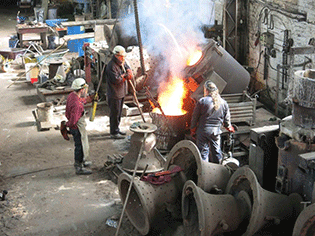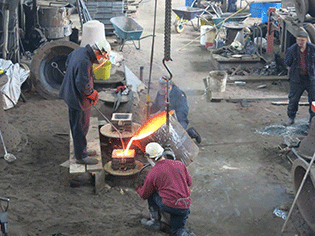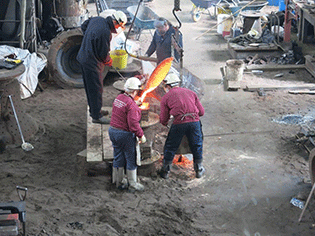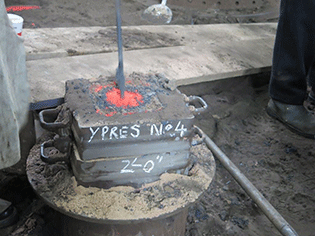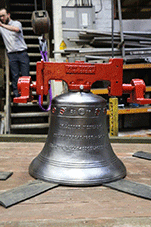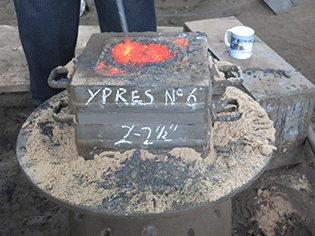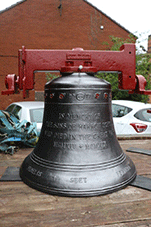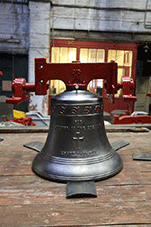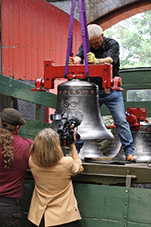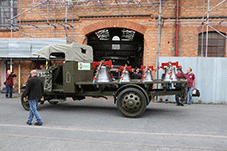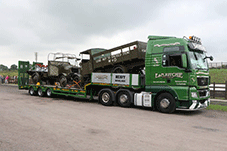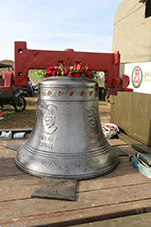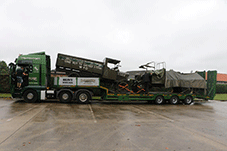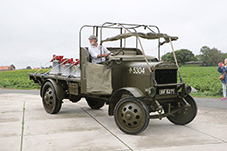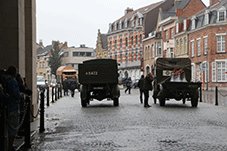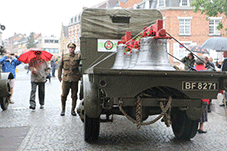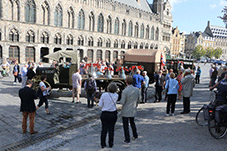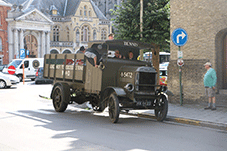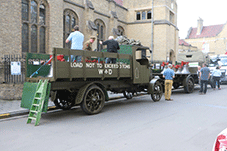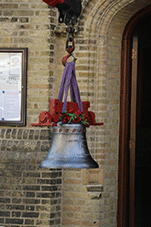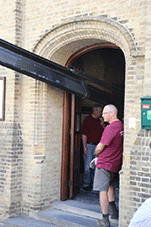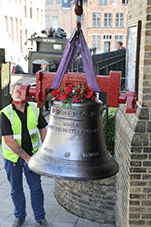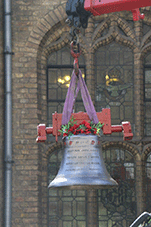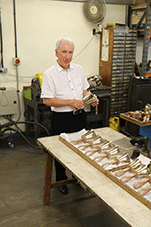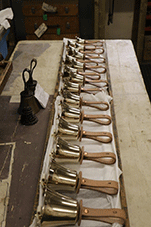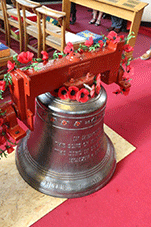
0
P A U L F O S T E R
St George's Memorial Church New Bells
St George's Memorial Church
New Ringing Bells Installed
New Ringing Bells Installed

Under the inspiration, driving force and dedication of Alan Regin, St George’s Memorial Church now has a new set of bells and these, in comparison to those they replaced, are capable of being rung.
Alan has been Steward of the Central Council Rolls of Honour for several years. He has worked hard to ensure that the rolls are as complete as possible, to the extent that an additional volume was required. He is also responsible for most of the photos and other additional material now forming part of the online version of the Rolls of Honour having visited many of the war cemeteries and memorials around the world where ringers are commemorated (or for some of the more distant ones, such as Port Stanley in the Falkland Islands, persuading other ringers to visit and take photographs when their trips took them nearby). During the centenary period he has organised publication in The Ringing World of monthly lists of ringing casualties for that month a century ago, and been a member of the band for many of the peal and quarter peal attempts organised to commemorate those ringers who lost their lives. It was of particular pleasure to read that Alan’s devotion to campanology has been recognised in the 2018 New Year Honours List and awarded an MBE.
I was delighted to be able to assist with the organization of the delivery of the bells in Ypres but it was not a solo effort. A great deal of help was provided by a host of good people in Ypres that included:
Schepen Verschoore from Ypres Town Council and a member of his staff, Peter Slosse;
Benoit Mottrie, Chairman of the Last Post Association;
Unloading the vehicles at Tyne Cot was arranged by Steven Vandenbussche;
The storage of the vehicles in the Infantry Barracks in Ypres was organised by Kolonel Christophe Onraet and his colleagues on site, Lieutenant Kolonel Carol Vermeulen and members of his staff.
A new ring of 8 bells which have been cast at the world famous bell foundry of John Taylor & Co in Loughborough for St George's Memorial Church in Ypres arrived in Ypres on Tuesday 30th August.
They left Loughborough on Tuesday 22nd August on First World War Dennis and Thornycroft army lorries owned by John Arthur and John Marshall from North Yorkshire. Richard Cockcroft assisted with the driving of the vehicles. Road transport was provided by Stuart Ritchie of E & N Ritchie Hauliers, Co Durham. The bells and lorries were part of the World War One commemorative display at the Great Dorset Steam Fair (from 24th to 28th August inclusive). The Great Dorset Steam Fair sponsored the road transport costs from Loughborough, Leicestershire, to the Great Dorset Steam Fair and then onto Ypres.
The bells and the lorries programme was:
Wednesday 30th August 2017
The Bells will be in Belgium and will travel from Tyne Cot Cemetery to the Menin Gate on the Dennis & Thornycroft lorries were present at the Last Post Ceremony at 8.00pm. The route and timings were:
2.30pm - 4.30pm Tyne Cot Cemetery Parking area
5.10pm - 5.35pm Hooge Crater Cemetery
5.50pm - 6.25pm Perth Cemetery (China Wall)
6.40pm - 7.15pm Railway Dugouts Burial Ground (Transport Farm)
7.30pm Arrive at Menin Gate
8.00pm Last Post Ceremony at the Menin Gate
8.30pm Depart Menin Gate
Thursday 31st August 2017
The Bells travel to St George's Memorial Church on the Dennis & Thornycroft lorries via Ypres Reservoir Cemetery and the Grote Markt, before arriving at the Church:
09.45am – 10.10am Ypres Reservoir Cemetery
10.20am – 10.50am The Grote Markt
11.00am Arrive at St George’s Memorial Church
At 5.00pm a special service was held in St George's Memorial Church where the bells were dedicated on the floor of the Church.
The fine tower of St George’s Memorial Church was built to contain change ringing bells, bells controlled by rope and wheel that turn through 360 degrees when they are rung and will be the first of their kind in Belgium. The inscriptions on the bells follow the same pattern of individual or group commemoration found in the church. Each bell has a Poppy motif cast around the shoulder.
The bells were hung in the tower during September and then other work in the tower was completed ready for the final dedication service which was held on:
Sunday 22nd October 2017
The bells were dedicated in the tower at a special service starting at 11.00am. The service was conducted by The Rt. Revd Dr Robert Innes, Bishop in Europe.
Handbells
A set of 16 Victorian handbells that belonged to a Great War Veteran have been donated to the project by John Coles. These will be fully restored by the Whitechapel Bell Foundry and be available to local and visiting ringers.
Memorial Book
Timothy Noad, professional illuminator and calligrapher, has been commissioned to create a Memorial Book that will be on display in the newly panelled ringing room. Each of the 64 inscriptions on the bells will be recorded in the book together with details of the donors.
Alan has been Steward of the Central Council Rolls of Honour for several years. He has worked hard to ensure that the rolls are as complete as possible, to the extent that an additional volume was required. He is also responsible for most of the photos and other additional material now forming part of the online version of the Rolls of Honour having visited many of the war cemeteries and memorials around the world where ringers are commemorated (or for some of the more distant ones, such as Port Stanley in the Falkland Islands, persuading other ringers to visit and take photographs when their trips took them nearby). During the centenary period he has organised publication in The Ringing World of monthly lists of ringing casualties for that month a century ago, and been a member of the band for many of the peal and quarter peal attempts organised to commemorate those ringers who lost their lives. It was of particular pleasure to read that Alan’s devotion to campanology has been recognised in the 2018 New Year Honours List and awarded an MBE.
I was delighted to be able to assist with the organization of the delivery of the bells in Ypres but it was not a solo effort. A great deal of help was provided by a host of good people in Ypres that included:
Schepen Verschoore from Ypres Town Council and a member of his staff, Peter Slosse;
Benoit Mottrie, Chairman of the Last Post Association;
Unloading the vehicles at Tyne Cot was arranged by Steven Vandenbussche;
The storage of the vehicles in the Infantry Barracks in Ypres was organised by Kolonel Christophe Onraet and his colleagues on site, Lieutenant Kolonel Carol Vermeulen and members of his staff.
A new ring of 8 bells which have been cast at the world famous bell foundry of John Taylor & Co in Loughborough for St George's Memorial Church in Ypres arrived in Ypres on Tuesday 30th August.
They left Loughborough on Tuesday 22nd August on First World War Dennis and Thornycroft army lorries owned by John Arthur and John Marshall from North Yorkshire. Richard Cockcroft assisted with the driving of the vehicles. Road transport was provided by Stuart Ritchie of E & N Ritchie Hauliers, Co Durham. The bells and lorries were part of the World War One commemorative display at the Great Dorset Steam Fair (from 24th to 28th August inclusive). The Great Dorset Steam Fair sponsored the road transport costs from Loughborough, Leicestershire, to the Great Dorset Steam Fair and then onto Ypres.
The bells and the lorries programme was:
Wednesday 30th August 2017
The Bells will be in Belgium and will travel from Tyne Cot Cemetery to the Menin Gate on the Dennis & Thornycroft lorries were present at the Last Post Ceremony at 8.00pm. The route and timings were:
2.30pm - 4.30pm Tyne Cot Cemetery Parking area
5.10pm - 5.35pm Hooge Crater Cemetery
5.50pm - 6.25pm Perth Cemetery (China Wall)
6.40pm - 7.15pm Railway Dugouts Burial Ground (Transport Farm)
7.30pm Arrive at Menin Gate
8.00pm Last Post Ceremony at the Menin Gate
8.30pm Depart Menin Gate
Thursday 31st August 2017
The Bells travel to St George's Memorial Church on the Dennis & Thornycroft lorries via Ypres Reservoir Cemetery and the Grote Markt, before arriving at the Church:
09.45am – 10.10am Ypres Reservoir Cemetery
10.20am – 10.50am The Grote Markt
11.00am Arrive at St George’s Memorial Church
At 5.00pm a special service was held in St George's Memorial Church where the bells were dedicated on the floor of the Church.
The fine tower of St George’s Memorial Church was built to contain change ringing bells, bells controlled by rope and wheel that turn through 360 degrees when they are rung and will be the first of their kind in Belgium. The inscriptions on the bells follow the same pattern of individual or group commemoration found in the church. Each bell has a Poppy motif cast around the shoulder.
The bells were hung in the tower during September and then other work in the tower was completed ready for the final dedication service which was held on:
Sunday 22nd October 2017
The bells were dedicated in the tower at a special service starting at 11.00am. The service was conducted by The Rt. Revd Dr Robert Innes, Bishop in Europe.
Handbells
A set of 16 Victorian handbells that belonged to a Great War Veteran have been donated to the project by John Coles. These will be fully restored by the Whitechapel Bell Foundry and be available to local and visiting ringers.
Memorial Book
Timothy Noad, professional illuminator and calligrapher, has been commissioned to create a Memorial Book that will be on display in the newly panelled ringing room. Each of the 64 inscriptions on the bells will be recorded in the book together with details of the donors.
Ypres Reservoir Cemetery
Captain Henry Basil Knott
9th Battalion Northumberland Fusiliers
Died on Tuesday 7th September 1915, aged 24
Grave reference V. B. 16.
9th Battalion Northumberland Fusiliers
Died on Tuesday 7th September 1915, aged 24
Grave reference V. B. 16.
Basil was born at the Manor House, Newcastle, on Thursday 5th February 1891, younger son of Sir James Knott, 1st Baronet, and Lady Margaret Knott, of Close House, Wylamon-Tyne, who was Member of Parliament for Sunderland in 1910. He was educated privately followed by Eton College as a member of Mr Arthur Conolly Gage Heygate’s House, leaving in 1910. He became a Director in the family shipping company, the Prince Line of Newcastle.
At the outbreak of war Basil volunteered and was commissioned in September 1914 and went into training with his brother at Bovington. He was promoted to Captain and left for Boulogne, France on Thursday 15th July 1915 on the SS Invicta. Basil was sent to northern France to complete his training before crossing the border to begin tours of duty in the front line.
Henry was in action at the Bois Carré, Vierstraat, and was mortally wounded in the head by a rifle bullet and was taken to No 10 Casualty Clearing Station at ‘Remy Sidings’ where he died the next day, and was buried in Poperinghe New Cemetery.
Henry left an estate of £20,196 13s 8d.
His father, Sir James, disposed of his company by the end of 1916 after the death of Basil’s brother, Jim and moved to Jersey. It was his wish to have the bodies of both his sons brought back to England but the authorities would not bend, despite him using all the connections and influence he had. Finally, they agreed that both boys would be buried next to each other, and so Basil was exhumed and moved to Ypres Reservoir and his brother brought from Fricourt, France.
There are buried now next to each and both graves carry the same inscription “Devoted in life, in death not divided”.
Basil and Jim Knott are commemorated on many memorials raised their memory. They include:
In the porch of St George’s Memorial Church, Ypres, there are three plaques to the Knott family including one to their father who donated large sums of money to the church. A trust fund in his memory was created that still operates to this day: www.knott-trust.co.uk
The inscriptions in St George’s Memorial Church read:
“To the glory of God and in memory of his two sons killed in action. Major James Leadbitter Knott, DSO, 10th West Yorkshire Regiment, Captain Henry Basil Knott, 9th Northumberland Fusiliers. This tower was given by Sir James Knott. MDCCCCXXVIIII.”
“To the glory of God and in memory Major James Leadbitter Knott, DSO, 10th West Yorkshire Regiment, Captain Henry Basil Knott, 9th Northumberland Fusiliers, killed in action the bells in this tower were consecrated 11th November 1997.”
They are commemorated at Collercoats, Heddon, and Wylam, a memorial park at Heddon was created by their father. In St James and St Basil, Fenham, Newcastle, a pair of stained glass window show each brother in uniform.
He was recorded in Debretts Obituary — War Roll of Honour published in the 1921 edition.
His eldest brother, Thomas, who was working in New Zealand at the outbreak of war, served during the war and survived. He succeeded to the title and lived in Courtland, Exmouth, Devon.
For further information, see ‘A History of the Knott Family’ by Joan R Duckett, and ‘Pride of the Princes - History of The Prince Line’ by Norman L Middlemiss.
Major James Leadbitter ‘Jim’ Knott, DSO
10th Battalion West Yorkshire Regiment (Prince of Wales’s Own)
Died on Saturday 1st July 1916, aged 33
Grave reference V. B. 15.
10th Battalion West Yorkshire Regiment (Prince of Wales’s Own)
Died on Saturday 1st July 1916, aged 33
Grave reference V. B. 15.
Citation for the Distinguished Service Order, London Gazette, Saturday 3rd June 1916:
“War Office, 3 Jun. 1916. His Majesty the King has been graciously pleased to approve of the undermentioned rewards for distinguished service in the field, dated 3 June, 1916.” His name is listed below.
Jim was born on Saturday 2nd December 1882, elder son of Sir James Knott, 1st Baronet, and Lady Margaret Knott, of Close House, Wylamon-Tyne, who was Member of Parliament for Sunderland in 1910. He was educated at Eton College as a member of the Reverend Henry Daman’s and Mr Hugh Vibart Macnaghten’s Houses, leaving in 1900 and then travelled extensively in North America. He was appointed Deputy Managing Director to his father in The Prince Line, a shipping company in Newcastle.
Like his father, Jim took a great interest in politics and was selected as the Conservative Prospective Parliamentary Candidate for Liberal-held constituency of Hyde. In 1916 a by-election was called in the seat but Jim gave up the opportunity of being the candidate so that he could remain at the front.
At the outbreak of war Jim volunteered and was gazetted and went into training with his brother at Bovington. He was promoted to Captain on Saturday 21st November 1914.
Early on Wednesday 14th July 1915 Jim arrived in Boulogne and entrained at 3.50pm for Lumbres. He marched with his men to billets in the Ouve area. Jim marched to Arques on Sunday 18th and after resting overnight moved to Steenvoorde. After the tiring march all ranks were delighted to have two days rest before continuing the march across the Belgian border to La Clytte, arriving in the early hours of Friday 23rd. All ranks were sent into the trenches in front of Kemmel for practical training with experienced, battle-hardened troops. On Monday 26th Private Arthur Hall was mortally wounded and died the next day; he was the first to be killed from the Battalion that brought home to everyone the reality of the Western Front — he is buried in Westouter Churchyard and Extension.
The Battalion began its first tour of duty in its own right on Monday 2nd August in the line between the Vierstraat to Wytschaete road and the Verbrandenmolen. At 10.45am a bombardment of the line began and at 11.10am the enemy blew a mine close to ‘B’ Company that wounded Lieutenant Maidlow and four of his men, however two German soldiers were killed! A week later Jim transferred north to support an attack at Hooge. A welcome break from the front line came early on Saturday 14th August when Jim arrived in La Clytte for twelve days of rest and training. When not instructing or organising his mens activities Jim was able to visit Bailleul and enjoy the cafés, concerts, restaurants and other facilities that abounded in the town. The reality of the Western Front returned on Thursday 26th when he marched with his men from La Clytte to relieve the Border Regiment in the front line near ‘Dead Dog Farm’, St Eloi.
The Battalion remained in the sector until the end of October when they were sent to Hooge that was described: “The trenches taken over were in a very bad condition. They had all suffered heavily from both our own and the enemy’s shellfire during the fighting between the end of July and the 25th September. Several trenches had been entirely destroyed and in the support and reserve lines it had not been possible to reconstruct them. North of the Menin Road the trenches varied from 80 to 20 yards distant from the enemy’s front trenches. The large crater blown up on June 10th, when the 3rd Division attacked, is 80 feet across and 40 deep. The inside has been constantly shelled and some hundreds of men are buried in it. On the line south of the Menin Road there is a gap of 200 feet between C.1 and C.3 trenches. It has never been possible to reconstruct the intervening trench C.2 as it is constantly destroyed by enemy fire. Zouave Wood is a mass of debris and broken trees. The enemy opposite are Wurtemburgers and regiments from Alsace.” Jim was relieved on Monday 1st November; he spent the rest of the month on tours of duty in the sector. The first ten days of December were spent in reserve at ‘York Huts’ before returning to Hooge for a tour. Jim and his men were looking forward to some rest in their camp at Busseboom, where they had arrived on Wednesday 15th December, but due to a gas attack they were stood to. Christmas Day was spent out of the line but Jim was back on duty in the trenches on Boxing Day where a raid was countered later in the evening.
Jim left the trenches of the Salient on Friday 7th January 1916 and after a series of marches with his men took them to Ruminghem where training continued until Saturday 5th February. He returned to a camp in Reninghelst on Monday 7th, a week later Jim was about to march to the line at St Eloi when the enemy blew a mine under ‘The Bluff’ so the relief was postponed. It was not until 6.00pm did the Battalion relieve the 10th Battalion Lancashire Fusiliers. Jim continued fighting in the sector and on Monday 28th February the Brigade Diary recorded: “10th West Yorkshire’s Intelligence Officer has sent in reports of considerable value as to the enemy’s works on the Bluff, which has enabled the artillery to destroy them. This officer, and the Intelligence Officer of the 7th Yorkshires, also discovered some enemy strong points opposite the trenches held by their Regiments. These are being destroyed by the siege battery.” Following a terrific bombardment on Wednesday 1st March the Battalion was involved in a fierce fight and lost one hundred and twenty officers and men, killed and wounded.
Active service in Belgium ended on Sunday 12th March; Jim was moved to the Armentières sector a week later where he remained until being sent south on Friday 12th May to train at Bayenghem for the Battle of the Somme. The first main action that Jim would take part in was at Fricourt, as described in the Divisional Diary: “As Fricourt Village and Wood had been excluded from attack in the first phase of operations, it was decided to cover the right flank of the 21st Division, by occupying the north edge of Fricourt village as far as Red Cottage and Lonely Copse. This attack was allotted to the 50th Infantry Brigade, which was therefore detached and placed under the orders of the G.O.C., 21st Division, and under his orders this brigade took over the trenches opposite Fricourt Village, with instructions to advance against their objective at 7.30 a.m. on the 1st July.”
The Battalion received the following order for the attack: “The 7th Yorkshire Regiment will assault on a front from the Wing Corner to south side of German Tambour in conjunction with the 22nd Brigade on the right, with the following objectives:
(1) Of clearing up to the eastern edge of Fricourt Village
from Well Lane to Cottage Trench and Cottage Trench
to Willow Avenue, there joining with the 22nd Brigade
(7th Division). On reaching this objective the Battalion
will re-organize with the objective of
(2) Clearing Fricourt Wood as far as Willow Trench and the
track leading N.N.E. to X.28.C.8.0 as soon as the
barrage on the west front of Fricourt Wood lifts (i.e. 2nd
Zero plus fifteen minutes from S.W. edge of wood and
2nd Zero plus one hour forty-five minutes from a parallel
line 150 yards back from edge of wood).
The 10th West Yorkshire Regiment will co-operate with the 7th Yorkshire Regiment against both objectives.
The boundary between the two battalions will be —
(1) Through Fricourt village:- The line of trenches running
from the junction of Hare Lane and Red Trench to Well
Lane at F.3.b. central,
(2) Through Fricourt Wood:- Roughly the line of clearing
running N.E. through the middle of the wood.”
At 7.30am Lieutenant Colonel Arthur Dickson and Jim (his Second in Command) led the third and fourth companies forward only to be cut down by machine gun fire, they and most of their men were killed. The War diary reads: “On 1st July 1916 at 7.30 a.m. the Battalion took part in the grand assault. Casualties were very heavy, chiefly, caused by machine guns which enfiladed our left flank and were so deadly that the third and fourth lines failed to get across ‘No Man’s Land’, resulting in 22 Officer casualties, including the Commanding Officer, Lt.-Col. Dickson and Major J. L. Knott, Second in Command were both killed and approximately 750 other ranks.”
Jim was originally buried alongside Lieutenant Colonel Dickson in Fricourt New Military Cemetery. After the war he was reburied with his brother, see above.
A letter that Jim wrote home the day he was killed is displayed in the West Yorkshire Regiment Memorial Chapel in York Minster. The envelope was marked: “This letter is only to be sent to my father in the event of my death before 15 July 1916.” The letter reads:
British Army in the Field
1 July 1916
My dearest Father and Mother,
If you are reading this letter is means that this war has demanded the extreme sacrifice from me, and my object in writing is to bring you as far as I can, some measure of consolation and courage and patience to bear your sorrow.
It is not in any sense a message from the grave because whatever I may or may not doubt, I have very complete faith in the Life Eternal.
I know that I will be with you when you are reading this, and I want you to realise, and always remember that, although Providence has been decided that I may not return to you in the flesh, that I shall be always with you in the Spirit sharing your joys and sorrows.
I feel compelled by my knowledge of you both to write this, because my own great anxiety at the present time is the possibility of your collapse if I follow ‘Pomp’.
Momentous events are looming up and I have a premonition that I may not return to you. I have been dreaming of Basil recently, and I have an indistinct recollection of a letter in Basil’s handwriting dated June 1916, which I feel is his warning message. If I am correct then you will both know Basil and I are happy.
I hope and desire above all things that you will unduly grieve. You must not think harshly of me for refusing to accept safe employment, even if my action results and your sorrow. We have all to show courage — those out here in facing the music and taking what comes in a stoic manner — those at home in facing the loneliness that must follow the casualties of severe fighting.
I do want you to know and realise how deeply and whole-heartedly I have appreciated and loved you both for your unselfish devotion and all-forgiving love. My life has been one uninterrupted period of all that a man could wish for or desire. If I die now I am content to do so. Life is sweet, and holds out all that a young man could desire — power, wealth and above all, great love, but I want you to know that I faced the future fearlessly, and that I was cheerful and satisfied.
My medals are yours but I should like them destroyed when you both join me — whenever that may be.
Always remember that I am relying upon you both to be good brave parents, and that I can only be really happy in a new life if I know and can see that you are happy too.
My clothes, furniture and motor car must all be immediately disposed of, everything which reminds you of my death must be removed — this is my urgent desire and wish.
God grant that you will be given health, strength and happiness for many years.
Your devoted son,
Jim
Jim left an estate of £104,350 2s 0d.
He is commemorated on several memorials, see his brother above for further details.
Jim was recorded in Debretts Obituary — War Roll of Honour published in the 1921 edition.
© PAUL FOSTER - ALL RIGHTS RESERVED.
